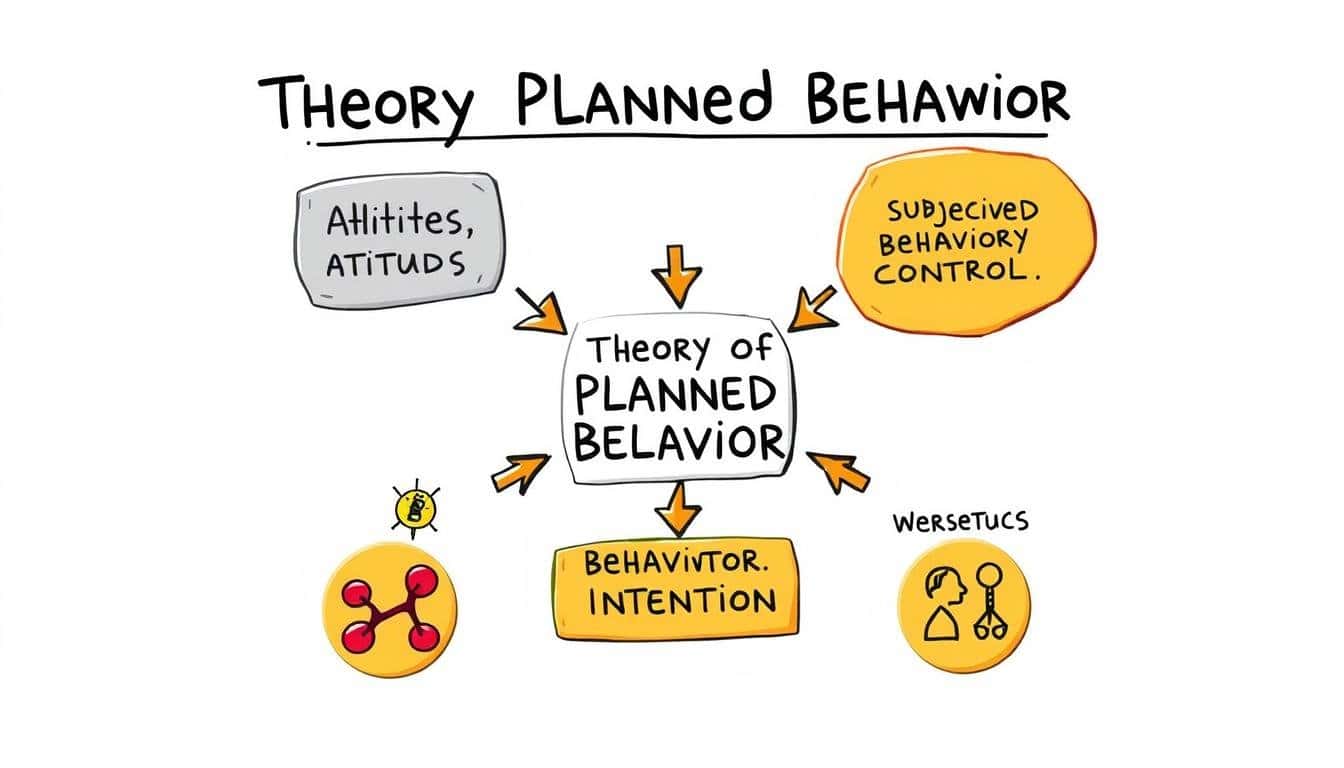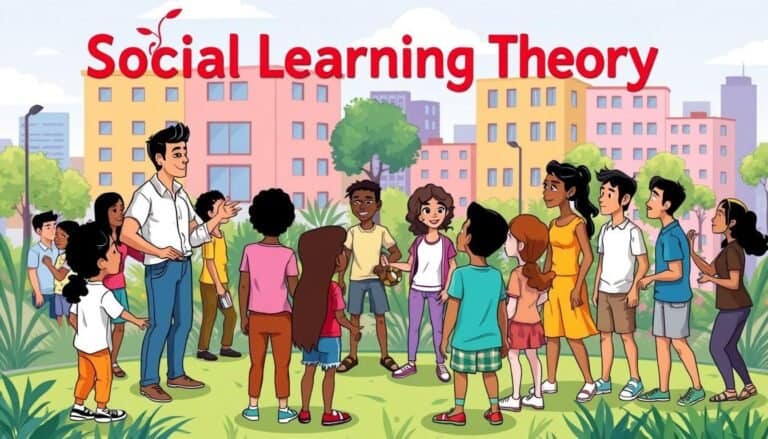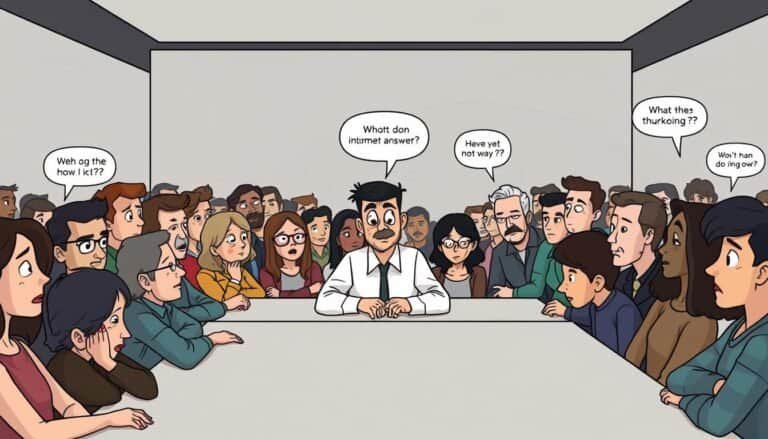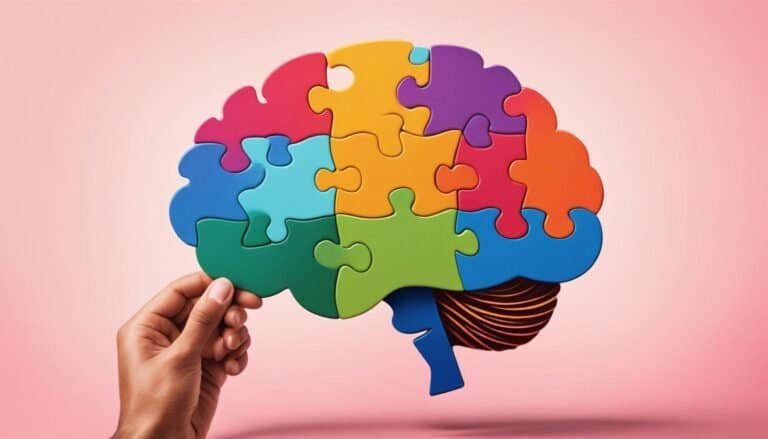Understanding Ajzen’s Theory of Planned Behavior
Ever wondered why some plans turn into actions, while others don’t? This mystery is central to The Theory of Planned Behavior (Ajzen). Developed by Icek Ajzen in 1985, it helps us understand human behavior. It shows that our actions come from three main parts: our feelings about the action, what others think, and how we see our control over the action.
This theory helps us see why we make certain choices and how they turn into actions. In a world full of social and personal influences, knowing about TPB is key. It’s important for fields like psychology, health, and social sciences.
Key Takeaways
- The Theory of Planned Behavior includes three essential components: attitude, subjective norms, and perceived behavioral control.
- Ajzen’s Theory suggests that behavioral intention is a key determinant of human social behavior.
- Perceived behavioral control reflects one’s belief in their ability to perform a behavior, influencing intentions and actions.
- Behavioral intentions are often moderated by perceived behavioral control, which may not always align with actual behavior.
- Subjective norms highlight the social pressures influencing decisions, derived from beliefs about others’ expectations.
- Understanding TPB can enhance strategies in health promotion and behavioral change initiatives.
- The insights gained from TPB can inform various sectors, from marketing to public health, enabling targeted approaches to influence behavior.
Introduction to Behavioral Theories
Understanding how people make decisions is key to predicting human behavior. Behavioral theories help us see what affects our actions. The Theory of Planned Behavior (TPB) model is a big part of this, helping us understand actions in social and mental ways.
Behavioral theories have grown a lot over time. Ajzen and Fishbein’s 1980 book started the theory of reasoned action. It looked at what people think and what others do. Then, in 1985, Ajzen added something new to the TPB model, called perceived behavioral control. This made the model better at predicting actions by looking at control over actions too.
Later, in 1991, Ajzen talked more about what affects our actions and beliefs. The TPB model showed how important it is for understanding behavior. In 2007, Ajzen and Fishbein shared how the theory can be used in many areas, like health promotion.
Today, research on behavioral theories keeps showing how well the TPB model works in real life. It helps us understand big changes in health and social actions. The TPB model gives us a clear way to see why people act the way they do.
Overview of the Theory of Planned Behavior (Ajzen)
The Theory of Planned Behavior (TPB) helps us understand how our beliefs guide our actions. It shows how our intentions and actions are linked. Ajzen’s work in 1991 built on the Theory of Reasoned Action, making TPB a key theory today.
Definition of the Theory
TPB says our behavior is shaped by three main things: our attitude towards the action, what others think, and how easy we think it is to do. Ajzen’s theory shows that what we plan to do is a strong guide to what we actually do. It believes we make choices based on these factors, aiming for a logical way of acting.
Historical Context and Development
Ajzen’s Theory has grown a lot since it first came out. It started from the Theory of Reasoned Action and added more to it, making it more useful in many areas. Its history shows how important it is, especially in health research. Many studies have used it to look at things like quitting smoking and drinking.
Through more research and updates, Ajzen’s Theory has shown it can really help predict how we act. This look at TPB highlights its strong base and its ongoing role in understanding how we behave.
Key Components of the TPB Model
The Theory of Planned Behavior (TPB) has three main parts that help us understand how people make decisions. These parts help us guess what people will do. They are attitude, subjective norms, and perceived control. Each one is important in deciding if someone will do something.
Attitude Toward the Behavior
Attitude is how a person feels about a behavior. It can be good or bad. This feeling comes from what they think will happen because of the behavior. For example, liking condoms can make people use them more, as seen in studies like Albarracín et al. (2001).
Subjective Norms and Their Influence
Subjective norms are what people think others expect them to do or not do. It’s based on what others think and how much someone wants to follow those expectations. Studies show that what others think really changes behavior, especially when friends and family matter a lot. People might do things because their loved ones suggest it, showing how important social influence is.
Perceived Behavioral Control
Perceived behavioral control is how easy or hard someone thinks a behavior is. It includes things like confidence in oneself and the resources available. Research like Armitage and Conner (1999) shows that feeling in control affects actions, like eating habits. The more in control someone feels, the more likely they are to act on their plans, which is key in the TPB model.
| Component | Description | Influence on Behavior |
|---|---|---|
| Attitude | Evaluation of behavior as positive or negative | Directly correlates with likelihood of engaging in behavior |
| Subjective Norms | Perceived social pressures from important others | Affects willingness to conform to social expectations |
| Perceived Behavioral Control | Belief in the ease or difficulty of performing the behavior | Influences intention and actual performance of behavior |
Knowing about these key parts of TPB helps us guess what people will do and how to help them. This is important for many areas like health, the environment, and education.
The Role of Intentions in TPB
Intentions are key in the Theory of Planned Behavior (TPB). They push people towards certain actions. Understanding these intentions helps predict actions in areas like health and voting. The main factors that shape these intentions are attitudes, social norms, and how much control someone feels they have over their actions.
Understanding Behavioral Intentions
Behavioral intentions show how likely someone is to take a certain action. The TPB says that stronger intentions mean a higher chance of acting. In a study on voting for EU integration, people said how likely they were to vote, from “definitely not” to “yes, definitely.” This helped researchers understand the link between intentions, attitudes, and voting control among 402 people.
Intentions as Predictors of Behavior
Intentions are not just about motivation but also predict behavior well. Studies show that feeling in control can make people less influenced by others. For instance, in the EU integration study, measuring intentions was very consistent. This shows a strong connection between intentions and the factors that influence them. The mix of social norms, attitudes, and control shapes how people act, proving intentions are crucial in the TPB model.
| Factor | Description | Impact on Intention |
|---|---|---|
| Attitude | Personal evaluation of the behavior | Positive attitudes lead to stronger intentions |
| Subjective Norms | Perceived social pressure to perform the behavior | High perceived social support enhances intentions |
| Perceived Behavioral Control | Individual’s belief in their ability to perform the behavior | Greater control correlates with more robust intentions |
Application of TPB in Real-Life Scenarios
The Theory of Planned Behavior (TPB) is key in many real-life situations, especially in public health. It helps us understand and change behaviors like using condoms and using social media. Studies show how TPB helps us see and change these behaviors.
TPB in Public Health Initiatives
Public health uses TPB to shape and predict health behaviors. It looks at attitudes, what others think, and how easy it feels to behave a certain way. This helps make people more aware and change their behaviors for the better. For example, it helps people quit smoking or breastfeed more.
Study on Condom Use Behavior among College Students
A study with 218 college students showed how TPB predicts condom use. Attitudes towards condoms and feeling in control of using them were big factors in their intentions. The study found that these TPB parts really did affect how often they used condoms. This shows how important it is to focus on these areas in health campaigns.
TPB and Social Media Use
TPB also helps us understand social media use. Attitudes and feeling in control can affect how much people use social media. But, these effects can vary a lot depending on who you are and what platform you use. This means we need to look more into how TPB can help us understand and change social media use.
| Construct | Function | Impact on Behavior |
|---|---|---|
| Attitudes | Individual beliefs about the outcomes of a behavior | Influence willingness to perform the behavior |
| Subjective Norms | Perceived social pressures to engage in a behavior | Affect intentions based on societal expectations |
| Perceived Behavioral Control | Individual’s perception of their ability to perform the behavior | Correlate with actual behavior execution |
These studies and applications give us new ways to improve public health strategies. They help us understand behaviors better, leading to more effective interventions.
The Theory of Planned Behavior (Ajzen)
Ajzen’s framework looks at what affects TPB and how it helps predict behavior. It shows that things like what others think and how easy a behavior is can affect us differently. TPB is good at predicting behavior in certain situations but not always, showing its strengths and limits.
Constructs that Influence the Theory
TPB includes six key parts: attitudes, intentions, norms, social norms, power, and control. Attitudes tell us how much someone likes a behavior. Intentions are key to predicting behavior, with a strong intention meaning someone is more likely to act.
Subjective norms show if people think others support a behavior. Social norms tell us what’s common in a group. Perceived power and control affect how easy or hard it is to do something.
Behavioral Predictability
Understanding how well TPB predicts behavior is crucial. It’s been tested in health and environmental fields. For example, feeling in control of saving energy was linked to stronger intentions.
In voting, feeling in control of voting issues changed people’s intentions. These studies show TPB’s strength in predicting behavior by looking at many factors together.
Limitations of the Theory of Planned Behavior
The Theory of Planned Behavior (TPB) is used in healthcare and environmental conservation. Yet, it has big problems. Critics say it doesn’t fully understand human behavior. Trying to predict what people will do is harder than the theory suggests.
Challenges in Prediction Accuracy
One big issue with TPB is its focus on rational thinking. It assumes people think carefully about what they do. But, studies show that feelings and the situation matter a lot too. This can mess up the TPB’s predictions.
Overemphasis on Rational Decision Making
TPB doesn’t consider how feelings and past experiences affect our choices. Research shows it misses the mark on impulsive actions. It’s not enough to just think things through. Human behavior is more complex than that.
| Study | Focus | Findings |
|---|---|---|
| Armitage & Conner (2001) | Health Behavior Modifications | Highlighted TPB effectiveness but noted limitations in emotional influences. |
| Godin et al. (2008) | Healthcare Professionals’ Intentions | Revealed discrepancies in intentions versus actual behaviors. |
| Alhamad & Donyai (2020) | Intentions in Medication Reuse | Illustrated how past experiences shape future intentions. |
| Michie (2005) | Implementing Psychological Theories | Proposed a consensus approach for enhanced practical applications. |
| Hui et al. (2020) | Pharmaceutical Packaging Improvements | Showed alignment with TPB principles in reducing medicinal waste. |
Comparative Analysis with Other Theories
The Theory of Planned Behavior (TPB) gives a deeper look at why people act the way they do. It builds on the Theory of Reasoned Action (TRA) by adding perceived behavioral control (PBC). This change helps predict behavior better, especially when people face obstacles.
For instance, how much students want to start their own business depends a lot on how much they feel they can control it. This shows how important it is to compare TPB with other theories in different situations.
Theory of Reasoned Action vs. TPB
TRA says that what you intend to do comes from your feelings about it and what others think. TPB adds PBC, which looks at how much control you think you have over the action. Comparing the two, TPB is better at predicting behavior in complex situations.
In real-life situations, like promoting health or changing behaviors, TPB is more accurate. This makes it a better choice for planning interventions.
Connection to Expectancy-Value Theory
Expectancy-Value Theory also helps us understand why people aim for certain goals. It says people look at how likely they are to succeed and how much they value the outcome. This idea fits well with TPB, giving us a clearer picture of why people make certain choices.
Together, these theories show how complex human behavior is. They highlight the many things that affect our decisions.







